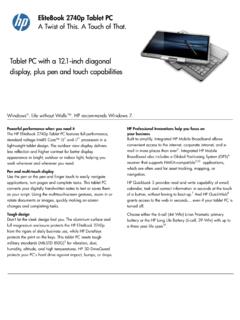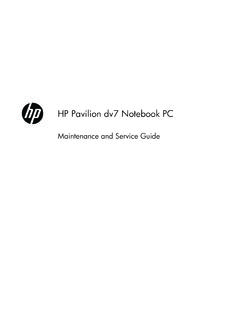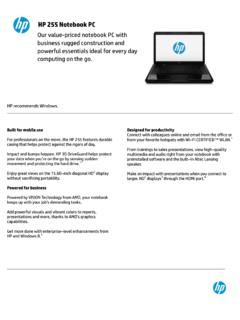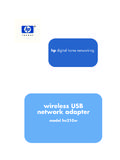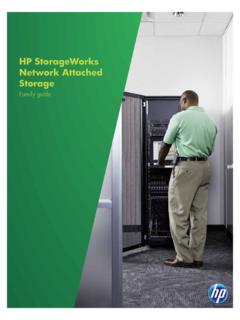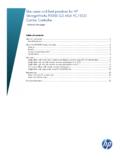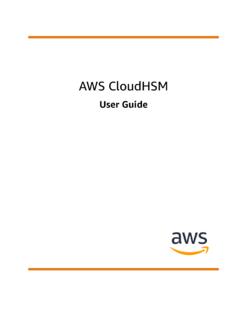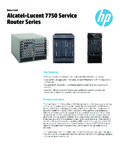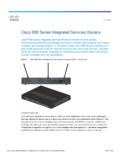Transcription of HP 10500 Switch Series
1 Data sheet HP 10500 Switch Series Key features Advanced, next-generation Clos architecture More than 11 terabits-per-second switching capacity Feature-rich, with IPv6 and MPLS functionality HP IRF technology virtualizes up to four chassis Ultra-high 1/10/40 GbE density; 100 GbE ready Product overview The HP 10500 Switch Series sets a new benchmark for performance, reliability, and scalability with a next-generation Clos architecture. Designed for enterprise campus core networks, the HP 10500 Switch Series enables a cloud-connected and media-rich capable infrastructure. The 10500 Series provides industry-leading 10 GbE/40 GbE port density, 3-microsecond latency, and very low energy consumption.
2 With HP Intelligent Resilient Framework (IRF). technology, the scalability and resiliency of the 10500 Switch Series can be extended and virtualized across up to four chassis with a single management interface, enabling flatter, more agile networks. The HP 10500 Switch Series , along with the entire HP FlexNetwork architecture, can be seamlessly managed through the single pane-of-glass HP Intelligent Management Center (IMC). Features and benefits Flexible port selection provides a combination of fiber and copper interface modules, Product architecture 100/1000 BASE-X auto-speed selection, and 10/100/1000 BASE-T. auto-speed detection plus auto duplex and MDI/MDI-X.
3 NEW Advanced Comware modular operating system brings native high stability, independent process monitoring, and Monitor link restart through the modular design and multiple processes of HP collects statistics on performance and errors on physical links, Comware v7 software; allows individual software modules to be increasing system availability upgraded for higher availability and supports enhanced Dual-personality functionality serviceability functions includes four 10/100/1000 ports or SFP slots for optional fiber NEW In-service software upgrade (ISSU) connectivity such as Gigabit-SX, -LX, and -LH, or 100-FX. provides an upgrade of the entire chassis, or an individual task or Packet storm protection process, with zero packet loss protects against unknown broadcast, unknown multicast, or unicast Distributed architecture with separation of data and control storms with user-defined thresholds delivers enhanced fault tolerance and facilitates continuous Flow control operation and zero service disruption during planned or unplanned control-plane events provides back pressure using standard IEEE , reducing congestion in heavy traffic situations Performance Quality of Service (QoS).
4 High-speed fully distributed architecture IEEE prioritization provides up to Tb/s switching capacity with released line cards and up to Tb/s switching fabric capacity with Type D delivers data to devices based on the priority and type of traffic fabric; modules provide nonblocking wirespeed 10 GbE/40 GbE Class of Service (CoS). performance and future 100 GbE expansion capability; with four sets the IEEE priority tag based on IP address, IP Type of fabrics, the Switch delivers up to billion pps throughput; all Service (ToS), Layer 3 protocol, TCP/UDP port number, source port, switching and routing is performed in the I/O modules; meets the and DiffServ demand of bandwidth-intensive applications today and in the future Bandwidth shaping Scalable system design provides investment protection to support future technologies and Port-based rate limiting provides per-port ingress-/egress-enforced increased bandwidth higher-speed connectivity, as the Switch is designed for increased backplane bandwidth Classifier-based rate limiting uses an access control list (ACL) to enforce increased bandwidth Flexible chassis selection for ingress traffic on each port enables you to tailor product selections to your budget with a choice of four chassis.
5 The 10504 Switch (four open module slots), 10508 Reduced bandwidth Switch (eight open module slots), 10508-V Switch (eight vertical provides per-port, per-queue egress-based reduced bandwidth open module slots), and 10512 Switch (12 open module slots). Traffic policing supports Committed Access Rate (CAR) and line rate Connectivity High-density port connectivity Weighted random early detection (WRED)/random early detection offers up to 12 interface module slots; provides up to 96 40 GbE (RED). ports, 576 10 GbE ports, and 576 gigabit fiber/electrical ports per delivers congestion avoidance capabilities through the use of queue system management algorithms Jumbo frames Powerful QoS feature allow high-performance backups and disaster-recovery systems; supports the following congestion actions: strict priority (SP).
6 Provide a maximum frame size of 9K bytes queuing, weighted round robin (WRR), weighted fair queuing (WFQ), and WRED. Loopback supports internal loopback testing for maintenance purposes and Resiliency and high availability an increase in availability; loopback detection protects against Redundant/load-sharing fabrics, management, fan assemblies, incorrect cabling or network configurations and can be enabled on a and power supplies per-port or per-VLAN basis for added flexibility increase total performance and power availability while providing Ethernet operations, administration and maintenance (OAM) hitless, stateful failover detects data link layer problems that occurred in the "last mile".
7 Using the IEEE OAM standard; monitors the status of the link between the two devices 2. Hot-swappable modules Multiple internal power supplies allows replacement of modules without any impact on other provides high reliability; the 10504 Switch provides 3+1. modules redundancy; the 10508, 10508-V, and 10512 switches provide 5+1. redundancy Separate data and control paths separates control from services and keeps service processing Virtual private network (VPN). isolated; increases security and performance IPSec Passive design system provides secure tunneling over an untrusted network such as the delivers increased system reliability as the backplane has no active Internet or a wireless network; offers data confidentiality, components authenticity, and integrity between two network endpoints Intelligent Resilient Framework (IRF) Generic Routing Encapsulation (GRE).
8 Creates virtual resilient switching fabrics, where two or more transports Layer 2 connectivity over a Layer 3 path in a secured switches perform as a single L2 Switch and L3 router; switches do way; enables the segregation of traffic from site to site not have to be co-located and can be part of a disaster-recovery system; servers or switches can be attached using standard LACP Manual or automatic Internet Key Exchange (IKE). for automatic load balancing and high availability; can eliminate the provides both manual or automatic key exchange required for the need for complex protocols like Spanning Tree Protocol, Equal-Cost algorithms used in encryption or authentication.
9 Auto-IKE allows Multipath (ECMP), or VRRP, thereby simplifying network operation automated management of the public key exchange, providing the highest levels of encryption IRF capability provides single IP address management for a resilient virtual Management switching fabric of up to four switches Management interface control Rapid Ring Protection Protocol (RRPP) enables or disables each of the following interfaces depending on provides standard sub-200 ms recovery for ring-based Ethernet security preferences: console port, telnet port, or reset button topology Industry-standard CLI with a hierarchical structure Virtual Router Redundancy Protocol (VRRP) reduces training time and expenses, and increases productivity in allows groups of two routers to dynamically back each other up to multivendor installations create highly available routed environments Management security Device Link Detection Protocol (DLDP) restricts access to critical configuration commands; offers multiple monitors link connectivity and shuts down ports at both ends if privilege levels with password protection.
10 ACLs provide telnet and unidirectional traffic is detected, preventing loops in STP-based SNMP access; local and remote syslog capabilities allow logging of networks all access Hitless patch upgrades SNMPv1, v2, and v3. allows patches and new service features to be installed without provide complete support of SNMP; provide full support of restarting the equipment, increasing network uptime and industry-standard Management Information Base (MIB) plus private facilitating maintenance extensions; SNMPv3 supports increased security using encryption IEEE Link Aggregation Control Protocol (LACP) sFlow (RFC 3176). supports up to 128 trunks, each with 8 links per trunk; supports provides scalable ASIC-based wirespeed network monitoring and static or dynamic groups and a user-selectable hashing algorithm accounting with no impact on network performance; this allows network operators to gather a variety of sophisticated network Graceful restart statistics and information for capacity planning and real-time supports graceful restart for OSPF, IS-IS, BGP, LDP, and RSVP; the network monitoring purposes network remains stable during the active-standby switchover; after the switchover, the device quickly learns the network routes by Remote monitoring (RMON).
